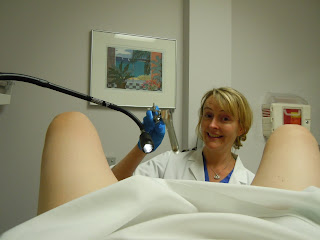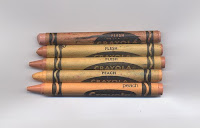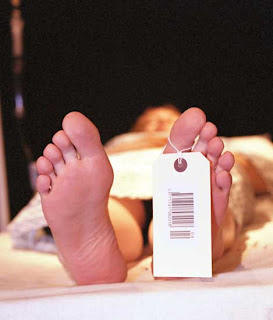It’s been recommended that hospital patients be issued flesh-colored gowns so that it would be easier to tell if they (the patients) turned blue or yellow later, which would be medically significant. This idea would never have occurred to me, for the same reason I would never have thought to inject my head with botulism poison just to see what happens. I’m not creative.
Most people have problems with hospital gowns. My problem is not what they expose, but that they’re sly about it. Even in my dreams, I don’t feel embarrassed until the moment I recognize that no one else in the House of Pancakes is naked. I’m fine up till then. But in the setting of the doctor’s office, when he or she peels back portions of your get-up as needed and then pats everything back in place again, it feels more like a strip-tease. I’d be less embarrassed if we dispensed with the gown altogether. Especially at the gynecologist’s office, where there doesn’t seem to be much point in modesty at all.
One time my gynecologist rolled in the door and asked me if I minded if a few students came in to observe the proceedings. She was pretty familiar with my sense of humor and thought I might be fine with that, and I was. In fact, it sort of reminded me of my twenties. But then the students filed in and pressed themselves up against the far wall in obvious discomfort. My doctor invited them to come look at this or that, and to a man, they had the same look a four-year-old gets when he’s being boosted up to the casket to give Grandma one last kiss. I didn’t start out embarrassed; I caught it from the students.
Anyway, the issue with the standard hospital gowns is that they tend to be blue or green and a change in skin color is not as noticeable as it might be if the gowns matched the patient’s (original) skin color. It’s probably true. I know that never once have I been in for a check-up and had the doctor say, “didn’t you used to be pinkish?” So maybe the gown throws them off. If the colors weren’t problematic enough, lots of them come in some sort of pattern meant to be cheerful. And I have to admit: with the right plaid, I can’t tell a Norwegian from a Pakistani.
Of course, the hospital would have to stock up on a lot of flesh tones. Even Crayola abandoned its “flesh” crayon in 1962, admitting it didn’t cover all the bases. (It didn’t even cover one base. No healthy person in history has ever been the color of a “flesh” crayon. True to theme, Crayola renamed the crayon “peach,” because no peach has ever been that color either. They might as well have named it “avocado.”) There has also been talk of using flesh-colored sheets. If the patient is well matched to both gown and linens, he should disappear entirely. He might not get proper attention, but at least we’d know he was not cyanotic or jaundiced.
There are other possibilities. Dots wouldn’t work; they’d confuse the dermatology department. And we’d probably want to stay away from a hound’s-tooth. The patient could sit abandoned for hours, with all medical personnel assuming he’s already been checked.
A jungle print is another possibility. Except if the patient were to develop monkeys flying out his ass, the doctor might not catch it.
But how about a nice vertical stripe? As a diagnostic tool, vertical stripes would be invaluable. The next time the patient came in, if the stripes were going horizontal, the doctor would know to check for heart attack, pulmonary embolism or other forms of death.




As a medical professional, I am both impressed and profoundly amused by your wonderful ideas Murr!
Thank you. Just, thank you!
You are amazing, Murr. Did you really take those pictures at the gyno's office? Of course you did! Fortunately for me, you staged that last one… very creative post, filled with humor that made me laugh out loud.
Oh my gosh!I can't believe you took that photo in the office!!!!
I stopped going in for those inspections about 13 years ago–and haven't missed it one bit! Maybe I'll get some hounds-tooth unmentionables as an insurance policy against any possible inquisition.
Having just spent a couple days in the hospital getting poked, proded, heart catherized, electroded and God knows what else – in a greenish gown with patterns and lots of snaps – I can really appreciate this post! I think the odd pattern of the gown was meant to camouflage the increasing pattern of odd bruises all over my arms. Now, I understand the left elbow crease since that's where all my blood was drawn, and the 2 on my left wrist and hand where they COULDN'T draw the blood, and the one on my right hand where the IV went in. What I don't understand are all those other ones appearing on the backs and sides of my arms and torso. Wonder what REALLY happens when you are spaced out on valium while undergoing a "procedure". And what does "procedure" REALLY MEAN? Thanks for this post – and may I just tell you how wonderfully photogenic you are – even playing dead!!!
Gynecologist to Murr, "Oh, there's where I left my Timex!!! And it's still ticking!"
I don't like hospitals and don't want to talk about them. I might like hospitals if everyone walked around naked, 'cept me of course. Would you talk to someone about that?
Again, you astound me with your insight, your analysis, and your persnicketiness.
I like the stripes idea, myself. Very practical…
"I'd be less embarrassed if we dispensed with the gown altogether." So true! Especially when getting a smash-o-gram. What is the point of having a floppy top draped over one shoulder when someone you don't know has just grabbed your bared breast, stretched it out as far as it will go and then squished it between two plates of glass?
OK, now I've seen it all–a photo taken from between one's knees at the gyno office. Yipes. And a doctor willing to smile for it? Dude. I can't imagine pulling that off. Reminds me to get my decadal checkup. pbbbbbbh
Handy hint: get two johnnys. Put one on backward, the other one frontward. Wait, which way is frontward?
Personal observation: If you're sick (or in labor) enough, you won't be embarrassed by anything. Anything. Barrassed, maybe….
Ok, so I clicked on your link for flesh colored gowns cuz I couldn't believe this was actually being considered. Still, you gotta be kidding! I was a hospital nurse for 9 years and let me tell ya, you don't need no flesh colored gown to determine jaundice or cyanosis! Lips, eyeballs, fingernails will tell you pretty darned quick. Maybe we nurses are just quicker than those doctors they were doing the study for. Oh, my….did I say that?
As for the gowns, I absolutely agree. Especially at the gynie there's a lotta false modesty involved. But forget the gown, what's that sheet for? Is that supposed to protect us from seeing ourselves, or is it just to shield us from the reality of what's going on down south? For us deafies it's a communication barrier, so I just push it out of the way. My own form of ADA.
Thanks for sharing your appointment!
Stefanie
Black is the new green with stripes.
Murr, you come up with the awesomest picture ideas. Every time I see one I wonder what the planning, pre-conversation or persuasion must have been like, and usually, it can't POSSIBLY have been anything but amusing as hell.
This is why I love your blog. And why I will dread the next time I go into hospital. Just in case the mix up the stripes.
Men get the "turn your head and cough" routine, like it's supposed to aid the exam in some way. I think they just made that up so we wouldn't look down and make eye contact when the doc had his finger up our scrotum. I'm OK with that excuse in any event.
All the nurses in my doctor's office wear colorful gowns with lots of flowery pictures on them. Makes me want a sucker every time I leave… if I've been a good boy (which I usually am).
I'm pretty sure I'd either draw the line at the students joining in, or charge them for the peek.
I have no preference on the color of the gowns. Since you pretty much have to scrape me off the front of a truck to get me anywhere near a doctor, and at that point I can't imagine I'd mind if it was puce.
Murr, you are such a breath of fresh air in this stale aired old world. A+ for this one.
Tui
Oh no, Debwardart, are you okay? Do they have bruise-colored gowns? The other thing I DO NOT understand about them is when you put them on, nothing matches up. The hem on the left is nine inches below the right and the sleeve on one side actually appears to be protruding from the lower chest area. How hard can these things be to sew? Yeah, my gynecologist is cool. I gingerly suggested there be some photography and I couldn't get her to stop snapping. Some of the outtakes would put my blog in a whole other category.
Murr, loved the post, but you didn't mention the evil conspiracy to give everybody the wrong size gown, regardless of color or print!! My husband, 6'4", once got one that "barely" covered him, while his 5'4" roommate got one that trailed along on the floor, making him look like Swee'Pea from the old Popeye strip.
Having just read your 3 most recent posts, I'm having a hard time keeping my head on my shoulders from the laughing! You've got a great sense of humour! I can't believe you actually took that photo at the Doc's office… lol!
I just popped in from DJan's when she linked to that sandpyramid photo you took… I could easily spend 45' staring out at sea looking at whales as well! :o)
No more time now, but I'll be sure to come back and keep exploring in what promises to be a fun place to hang out!
cheers!
Having just read your 3 most recent posts, I'm having a hard time keeping my head on my shoulders from the laughing! You've got a great sense of humour! I can't believe you actually took that photo at the Doc's office… lol!
I just popped in from DJan's when she linked to that sandpyramid photo you took… I could easily spend 45' staring out at sea looking at whales as well! :o)
No more time now, but I'll be sure to come back and keep exploring in what promises to be a fun place to hang out!
cheers!
Having just spent a couple days in the hospital getting poked, proded, heart catherized, electroded and God knows what else – in a greenish gown with patterns and lots of snaps – I can really appreciate this post! I think the odd pattern of the gown was meant to camouflage the increasing pattern of odd bruises all over my arms. Now, I understand the left elbow crease since that's where all my blood was drawn, and the 2 on my left wrist and hand where they COULDN'T draw the blood, and the one on my right hand where the IV went in. What I don't understand are all those other ones appearing on the backs and sides of my arms and torso. Wonder what REALLY happens when you are spaced out on valium while undergoing a "procedure". And what does "procedure" REALLY MEAN? Thanks for this post – and may I just tell you how wonderfully photogenic you are – even playing dead!!!
I'm pretty sure I'd either draw the line at the students joining in, or charge them for the peek.
I have no preference on the color of the gowns. Since you pretty much have to scrape me off the front of a truck to get me anywhere near a doctor, and at that point I can't imagine I'd mind if it was puce.
This is why I love your blog. And why I will dread the next time I go into hospital. Just in case the mix up the stripes.
Can one comment over 7 years later? We shall see! I've just been quietly reading from Blog Zero, working my way toward the Now, but this one made me groan out loud and it doesn't appear that anyone else caught it!
"And we'd probably want to stay away from a hound's-tooth. The patient could sit abandoned for hours, with all medical personnel assuming he's already been checked."
Well played.
You're kidding me. You're going through ALL the archives? I'm shocked and humbled! Have fun!
Yep. I'm a complete-ist. It's also a wonderful way to start and finish my days–cup of coffee/glass of wine and a couple of Murrmurrs!
I totally agree to with your idea to dispense with the gown altogether, because really, what's the point? My gynecologist actually does not use gowns- He feels that patients are more comfortable without them. Sitting there bare naked is much better than wearing a too small paper gown that will probably rip if you try to move.